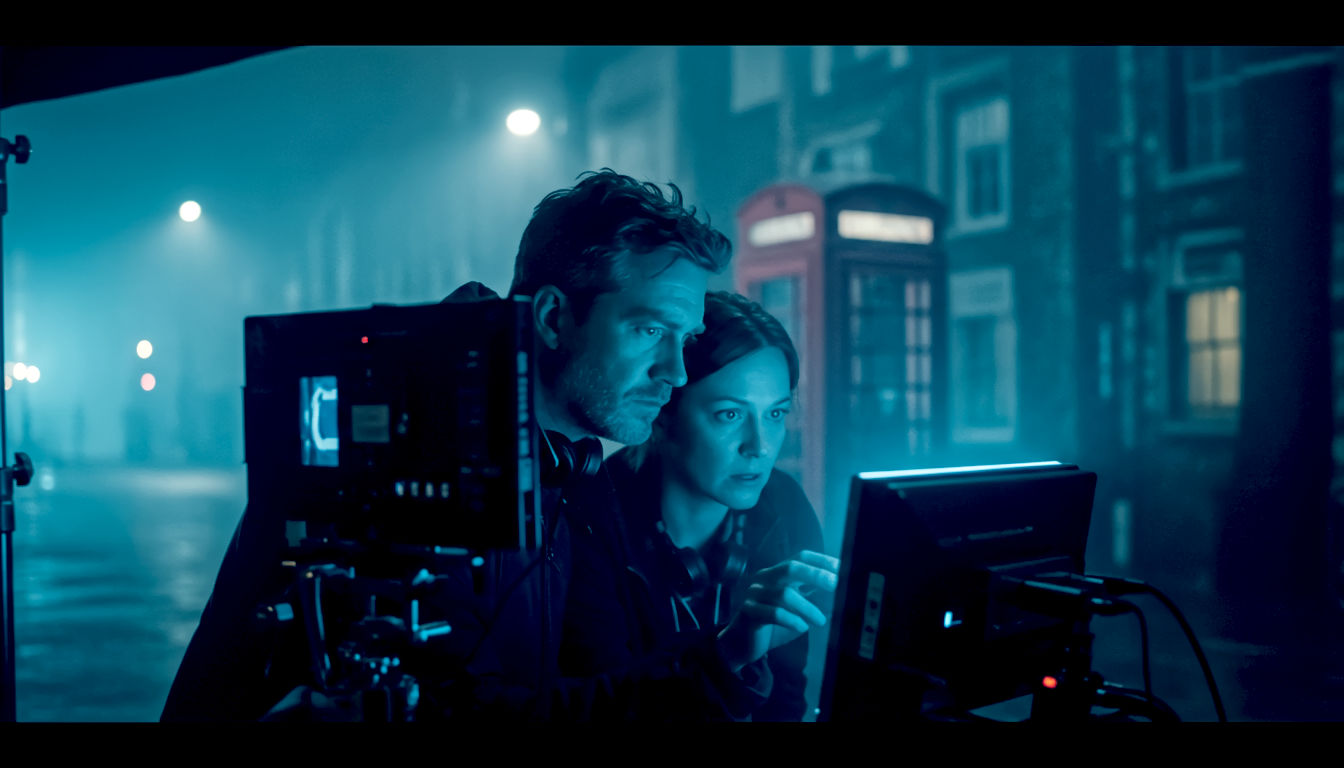The Director of Photography: Painting with Light and Shadow
Discover the magic behind your favourite films. This definitive guide explains what a Director of Photography is, from mastering light to leading the camera crew.

This post may contain affiliate links. If you make a purchase through these links, we may earn a commission at no additional cost to you.
Have you ever watched a film and felt a shiver down your spine, not because of a scary monster, but because of the way the rain streaks down a grimy London window? Or felt a surge of hope as the sun breaks over the Scottish Highlands, catching the hero’s face just so? If you have, you’ve felt the magic of the Director of Photography.
It’s one of those job titles you see in the endless credits after a film, scrolling past as you hunt for the leftover popcorn. ‘Director of Photography’. It sounds important, a bit grand, but what does it actually mean?
In short, they are the visual architects of a film. They are the artists who, in partnership with the director, decide how every single shot will look and feel. They don’t just point a camera at the actors; they paint with light, compose with colour, and tell stories with shadow. The director might be the author of the book, but the Director of Photography, or DP for short (sometimes also called a Cinematographer), is the illustrator who brings the words to life. They turn a script into a living, breathing world that you can fall into for two hours.
This guide will pull back the curtain on one of the most crucial and creative roles in filmmaking. We’ll explore what a DP really does, how they command an army of technicians, and why their work is the secret ingredient behind your favourite films and TV shows, from epic blockbusters to gritty British dramas.
What is a Director of Photography, Really? The Captain of the Visuals
Let’s get one thing straight from the off: the DP isn’t just a fancy camera operator. While they need to understand cameras inside and out, their job is far bigger. Think of the director as the film’s prime minister – they have the overall vision and make the final decisions. The DP, then, is their most trusted cabinet member, the Chancellor of the Exchequer for all things visual. Their job is to take the director’s ideas—”I want this scene to feel lonely,” or “This should be a really tense moment”—and translate them into a concrete visual plan.
This partnership is one of the most important in all of filmmaking. A director and a DP who are in sync can create magic. A famous British example is the collaboration between director Sam Mendes and cinematographer Sir Roger Deakins. For the film 1917, Mendes had a bold idea: to make it look like the entire film was one continuous shot. It was Deakins’ job to figure out how on earth to actually do that. He had to invent new camera rigs, plan every tiny movement, and choreograph an incredibly complex dance of actors, crew, and camera. The result was a breathtaking, immersive experience that simply wouldn’t have been possible without that perfect blend of directorial vision and cinematographic genius.
DP vs. Director vs. Camera Operator: Who Does What?
It’s easy to get these roles jumbled up. They all work with the camera, right? Well, yes, but their focus is very different. Here’s a simple breakdown:
- The Director: Is in charge of the overall story and performance. They work with the actors on their lines, decide the emotional tone of a scene, and have the final say on everything. They are the storyteller.
- The Director of Photography (DP): Is in charge of the visuals and the camera/lighting crew. They decide how to capture the story visually. They choose the lighting, the lenses, and the camera movements to create the mood the director wants. They are the visual artist.
- The Camera Operator: Is the person who physically operates the camera during a take. They follow the DP’s instructions precisely, ensuring the shot is framed correctly, the focus is sharp, and the movement is smooth. They are the skilled technician.
On smaller film sets, the DP might also operate the camera themselves. But on bigger productions, the DP will be stood next to the director, watching a monitor to make sure the visual plan is coming together perfectly, while the camera operator handles the machine.
The DP’s Toolkit: The Art and Science of a Perfect Shot
A Director of Photography commands a vast toolkit of creative and technical skills. They are part artist, part scientist, and part logician. Let’s break down the key areas they are responsible for.
Crafting the Film’s ‘Look’: The Visual Blueprint
Long before the cameras start rolling, the DP is working closely with the director and the production designer to define the film’s overall visual style. Will it be dark and gritty, like a British crime drama set in the underbelly of Manchester? Or bright and airy, like a Jane Austen adaptation set in the rolling hills of the Cotswolds?
This ‘look’ influences every decision that follows. They will create mood boards with paintings, photographs, and stills from other films to build a shared visual language. They’ll discuss the colour palette – for example, the film Paddington 2 uses warm, vibrant colours to create a feeling of comfort and joy, while a show like Peaky Blinders uses a desaturated, almost colourless palette to reflect the grim, industrial world of 1920s Birmingham. This is the DP’s first and most important job: to establish the visual DNA of the story.
Mastering Light and Shadow: The Soul of the Image
If a DP has one superpower, it’s their mastery of light. Lighting isn’t just about making sure you can see the actors. It’s about creating mood, directing the audience’s eye, and revealing character. It’s the difference between a flat, boring image and a rich, three-dimensional world.
A DP can make a character look powerful and heroic by lighting them from below, or vulnerable and afraid by casting them in deep shadow. They use light to sculpt the actors’ faces and the landscape around them.
- Simplified Explanation: Think about lighting a room in your house. A single, harsh lightbulb overhead makes everything look flat and uninviting. But if you use a few lamps in the corners, maybe a dimmer switch, you create soft pools of light and shadow that make the room feel cosy and interesting. A DP does this on a massive scale.
- Detailed Explanation: DPs use a technique called three-point lighting as a foundation. This involves a Key Light (the main, brightest light), a Fill Light (a softer light to fill in shadows), and a Backlight (a light from behind to separate the subject from the background). But they rarely stop there. They use dozens of different types of lights, from huge 20,000-watt lamps called ‘brutes’ to tiny LEDs they can hide in a plant pot. They also use flags (black boards) to block light and create shadows, and diffusion materials like silk to soften it. The person in charge of all the lighting equipment and electricians is called the Gaffer, and they are the DP’s right-hand person.
The great British cinematographer Jack Cardiff, who shot films like The Red Shoes (1948) and The African Queen (1951), was a master of Technicolor. He treated lighting like a painter, using bold, saturated colours to create worlds that were more vivid and emotional than reality. His work showed that light could be a character in itself.
Choosing the Canvas: Cameras, Lenses, and Film Stock
The choice of camera and lens has a huge impact on how the audience experiences the story. It’s like a painter choosing between watercolour, oil paint, or charcoal – each one creates a different texture and feel.
Film vs. Digital
For decades, films were shot on, well, film. Celluloid film has a unique texture, a grain, that many filmmakers love for its organic, timeless feel. Director Christopher Nolan, for example, is a famous champion of shooting on film, particularly large-format IMAX film, for his epics like Dunkirk.
Today, most productions are shot on high-resolution digital cameras. Digital offers incredible flexibility, especially in low light, and allows the DP and director to see exactly what they’re getting on set. The hit series The Crown, shot by various talented DPs, uses top-end digital cameras to achieve its famously crisp, stately, and polished look, perfectly fitting for a story about the Royal Family.
A DP needs to be an expert in both worlds and decide which format best serves the story.
The Power of the Lens
Lenses are the eyes of the camera. The DP’s choice of lens can dramatically change the feel of a shot.
- Wide-Angle Lenses: These lenses see a lot of the world at once. They can be used to show off an epic landscape, like the stunning vistas in Lawrence of Arabia (shot by British DP Freddie Young), or to create a sense of distortion and unease when placed close to a character’s face.
- Telephoto Lenses: These lenses act like a telescope, bringing things that are far away up close. They flatten the image and make the background feel compressed and blurry. This is great for making a character feel isolated or for creating a sense of being watched from a distance. You see this a lot in spy thrillers.
- Prime Lenses vs. Zoom Lenses: A prime lens has a fixed focal length (you can’t zoom in or out). Cinematographers often prefer them because they offer a sharper, higher-quality image. A zoom lens is more flexible but can sometimes be less optically perfect.
The DP’s lens choice is a subtle but powerful storytelling tool. A slight change in focal length can change the entire emotional tone of a scene.
The Dance of Movement: Moving the Camera, Moving the Audience
How the camera moves is just as important as what it sees. Camera movement isn’t just about following an actor as they walk across a room; it’s about giving the audience a specific point of view and controlling the pace and energy of a scene.
- Static Shot: A locked-off camera can create a sense of stability, or it can feel trapping and claustrophobic.
- The Pan and Tilt: Simple movements, left-to-right or up-and-down, used to reveal information or follow action.
- The Tracking Shot: The camera moves on a dolly (a small wheeled platform on tracks) or a Steadicam (a harness worn by the operator). This creates a smooth, floating movement that can immerse the audience in the action. Think of the famous long takes in the Harry Potter films, where the camera glides through the magical halls of Hogwarts.
- Handheld: A shaky, handheld camera creates a sense of urgency, realism, and chaos. It puts the audience right in the middle of the action. It’s used to brilliant effect in gritty war films and intense dramas to make you feel like you’re really there.
The person responsible for the camera movement equipment is the Key Grip, another of the DP’s key collaborators.
Composing the Frame: The Art of the Perfect Image
Finally, the DP is a master of composition. This is about arranging all the elements within the frame—the actors, the background, the furniture—to create an image that is balanced, visually interesting, and tells the story effectively.
They use classic principles of art and photography, like the Rule of Thirds, where the frame is divided into a 3×3 grid, and important elements are placed on the lines or intersections to create a more dynamic image. They think about leading lines (like a road or a fence) that draw the viewer’s eye towards the subject. They consider headroom (the space above an actor’s head) and negative space (the empty areas of the frame).
Look at any shot from a film by director Wes Anderson (often working with DP Robert Yeoman). His compositions are famously symmetrical and perfectly balanced, creating a quirky, storybook feel that is instantly recognisable. This isn’t an accident; every single object in the frame has been placed with meticulous care. That’s the art of composition.
A Potted History of Cinematography: The British Chapter
The role of the cinematographer has evolved massively over the last century, and British talent has been at the forefront of that evolution.
In the very early days of cinema, the person cranking the camera was just a technician. But filmmakers quickly realised that how you shot something was just as important as what you were shooting. Pioneers in the silent era started experimenting with lighting and camera angles to create mood and drama.
The “Golden Age” of British cinema in the 1940s and 50s produced some of the world’s greatest cinematographers. Jack Cardiff and Freddie Young were masters of their craft, shooting stunning epics that defined a generation of filmmaking. Young won three Oscars for his work on David Lean’s films: Lawrence of Arabia (1962), Doctor Zhivago (1965), and Ryan’s Daughter (1970). His ability to capture vast, awe-inspiring landscapes was legendary.
In more recent times, Britain has continued to produce world-class DPs. Sir Roger Deakins is arguably the most celebrated living cinematographer, with a stunning body of work that includes The Shawshank Redemption, Fargo, Blade Runner 2049, and 1917. He is known for his beautifully simple, naturalistic, and powerful images. He proves that the best cinematography doesn’t always shout for attention; sometimes it whispers.
Today, British DPs are working on everything from Hollywood blockbusters to cutting-edge television, continuing a long tradition of visual excellence.
The DP’s Team: It Takes a Village to Make a Shot
A Director of Photography never works alone. They are the head of two major departments on a film set: the Camera Department and the Lighting Department. They rely on a highly skilled team to execute their vision.
Here are some of the key players:
- Gaffer: The head of the lighting department (the Chief Electrician). The DP tells the gaffer what kind of lighting they want, and the gaffer and their team of electricians (sparks) make it happen.
- Key Grip: The head of the grip department. Grips are the expert riggers on set. They build the platforms for the camera, lay the dolly tracks, and set up the flags and diffusion frames that the DP uses to shape the light.
- Camera Operator: As we’ve discussed, the person looking through the viewfinder.
- First Assistant Camera (1st AC or Focus Puller): One of the most skilled jobs on set. This person is responsible for keeping the camera’s focus sharp. They don’t look through the camera; they judge the distance between the lens and the actor by eye and adjust the focus ring as the actor or the camera moves. It’s an incredibly difficult job that requires intense concentration.
- Second Assistant Camera (2nd AC or Clapper Loader): This person operates the clapperboard (the black-and-white slate that snaps shut at the beginning of a take), loads the raw footage or film stock, and keeps all the camera paperwork in order.
- DIT (Digital Imaging Technician): A more modern role. On a digital shoot, the DIT is responsible for managing all the data that comes from the camera. They download the footage, check it for technical problems, and often apply a first pass of colour correction so the director can see an image that’s closer to the final look.
A DP needs to be a great leader and communicator to manage this team effectively, often under intense pressure and with limited time.
From Script to Screen: The DP’s Journey
The work of a DP spans the entire filmmaking process, which is usually broken down into three stages.
1. Pre-Production: The Planning Phase
This is where the bulk of the DP’s creative work is done. It happens in the weeks and months before the shoot begins.
- Script Breakdown: The DP reads the script over and over, making notes on the visual opportunities and challenges in each scene.
- Creative Meetings: They spend hours with the director, production designer, and costume designer, nailing down the film’s visual style.
- Location Scouting: The DP visits potential filming locations to see how they can use the natural light or what equipment they’ll need to bring to light the space.
- Storyboards and Shot Lists: They work with the director to plan the shots for every scene. A storyboard is like a comic-book version of the film, while a shot list is a detailed document that lists every single camera setup required.
- Technical Tests: They will test different cameras, lenses, and lighting setups to see what works best for the film’s look.
By the time the first day of shooting arrives, the DP should have a complete visual blueprint for the entire film in their head.
2. Production: The Shooting Phase
This is the most intense part of the process. The DP and their team are on set, working long hours to bring the plan to life. Their daily routine involves:
- Blocking the Scene: The DP watches the director and actors rehearse a scene (the ‘blocking’) to understand where everyone will be moving.
- Lighting the Set: They then work with the gaffer and key grip to light the set and position the camera for the first shot. This can take anywhere from a few minutes to many hours, depending on the complexity of the scene.
- Shooting: They oversee the camera operator and focus puller during each take, watching a high-quality monitor to ensure the image is perfect. They are constantly making tiny adjustments to the light or the camera’s position.
- Problem-Solving: Filmmaking is all about solving problems. The sun might go behind a cloud, a light might break, or a shot that looked great on paper just might not work in reality. The DP has to think on their feet and come up with creative solutions fast.
3. Post-Production: The Finishing Phase
Once filming is over, the DP’s job isn’t quite done. They play a crucial role in the final stage of crafting the film’s look: colour grading.
The DP goes into a special grading suite with a Colourist. Here, they fine-tune the colour, contrast, and brightness of every single shot in the film. This is where they can really perfect the mood they planned back in pre-production. They can make the blues in a winter scene feel colder, or the reds in a fire feel more intense. It’s the final coat of paint on their visual masterpiece.
How to Become a Director of Photography in the UK
It’s a long and challenging road, but becoming a DP is one of the most rewarding jobs in the film industry. There’s no single path, but here are the key ingredients.
Essential Skills
- A Great Eye: You need a natural sense of composition, light, and colour. You should be constantly looking at the world around you, at paintings, and at photographs, thinking about how they are lit and framed.
- Technical Knowledge: You have to be a geek about cameras, lenses, and lights. You need to understand the science behind the art.
- Communication and Leadership: You have to be able to clearly explain your vision to a large team and inspire them to do their best work.
- Stamina: Film sets are demanding places. You’ll be working long hours, often in difficult conditions. You need to be physically and mentally tough.
- Problem-Solving: As we’ve seen, you need to be able to stay calm and find solutions when things go wrong.
Education and Training
Many DPs go to film school, like the prestigious National Film and Television School (NFTS) in Beaconsfield or the London Film School. These places provide a fantastic grounding in the craft and allow you to build a network of contacts.
However, a degree is not essential. Many DPs have worked their way up through the ranks on set. This is the traditional apprenticeship route. You might start as a Runner (making tea and doing odd jobs), then become a Camera Trainee, then a 2nd AC, then a 1st AC, then a Camera Operator, and finally, after many years of hard work and experience, you might get your shot at being a Director of Photography on a short film or a small project.
The most important thing is to get on set and learn from experienced professionals. You also need to build a portfolio. Shoot short films with friends, music videos, anything you can to practise your craft and create a showreel that you can use to get work.
The Future of Cinematography: New Tools, Same Art
The technology of filmmaking is changing faster than ever before. Virtual Production, using enormous LED screens called “The Volume” (as seen on The Mandalorian), is allowing DPs to shoot scenes in exotic locations without ever leaving a studio. Drones are providing camera angles that were once impossible. Cameras are getting smaller, lighter, and more sensitive to light.
But while the tools are changing, the fundamental art of the cinematographer remains the same. It’s still about understanding light. It’s still about composing a beautiful frame. And it’s still about telling a story.
No matter how advanced the technology gets, you will always need a human artist—the Director of Photography—to stand behind the camera, interpret the director’s vision, and make the decisions that turn a simple scene into a moment of cinematic magic. The next time you sit down to watch a film, pay attention to the light, the colour, and the camera’s movement. You’ll see the hand of the DP everywhere, quietly telling you the story, one perfect frame at a time.
Further Reading
For those interested in diving deeper into the world of cinematography, here are some highly respected resources:
- The British Society of Cinematographers (BSC): The official organisation for DPs in the UK, featuring interviews, articles, and news. https://bscine.com/
- British Cinematographer Magazine: An excellent trade publication covering the art and craft of cinematography in the UK and beyond. https://britishcinematographer.co.uk/
- American Cinematographer: The magazine of the American Society of Cinematographers (ASC), offering deep technical dives into major films and TV shows. https://theasc.com/american-cinematographer






